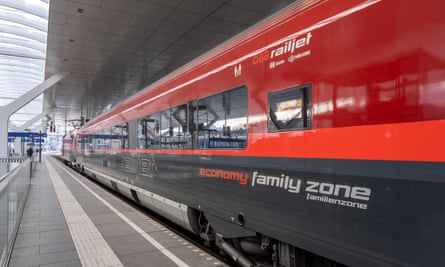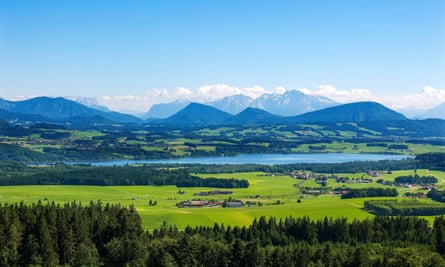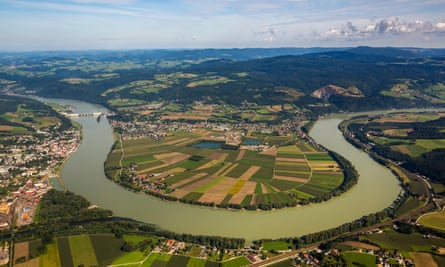Most travellers from Britain bound for the 1873 World Fair in Vienna would have had their first encounter with Austria in Salzburg, whence it was an easy onward journey to Vienna. In those days, the fastest train was the lunchtime express from Salzburg, which chugged to the Austrian capital in just under eight hours.
Times have changed. A glance at Table 950 in the March 2023 European Rail Timetable shows three direct trains each hour from Salzburg to Vienna, all taking under three hours for the 200-mile journey. It’s a fine ride – every bit as engaging today as it was when Thomas Cook’s clients, clutching their hotel coupons and pocket timetables, made their way to the World Fair.
The year 1873 was a very good one for Thomas Cook’s expanding travel business. By then the day-to-day management of the company was being handled by Thomas’s son, John Mason Cook. Thomas Cook, then in his 65th year, was away from late 1872 escorting what surely ranks as the first round-the-world package tour. It was an epic 222-day journey which, 150 years ago this month, saw Cook and his charges enjoying a spell in Jerusalem.

Meanwhile, back in the company’s London HQ, preparations were afoot for a busy 1873 Vienna programme. Much as Thomas Cook loved leading tours personally, his son John knew the importance of a scaleable business model, and that meant having clients head off without an escort. So the team in London compiled a handy pocket guide of European train times with an emphasis on routes to Vienna. So it was that 150 years ago this month, the first issue of Thomas Cook and Son’s continental timetable was published. For diehard devotees of online journey planners, it must be a source of wonder that this remarkable compendium is still published monthly today. When Thomas Cook Tour Operations axed its publishing division in 2013, responsibility for the title shifted to the newly formed European Rail Timetable Ltd.
The tabular format of the European Rail Timetable wins hands-down over an online journey planner when it comes to discerning the general pattern of a train service, rather than merely the departure and arrival times. The early editions helped Cook’s clients navigate their way to and from Vienna. And 150 years on, the monthly timetable is still the bible when it comes to planning Interrail trips or, for that matter, any long and meandering train journeys around Europe.
Railjet to Vienna
I opt for the 12.12 from Salzburg, as the bible reveals that this Railjet train makes extra stops along the way and is a shade slower than others. Who needs to dash, all the more so when the train has a restaurant car where, it turns out, I am the only taker for lunch. The first part of the run out from Salzburg is superb, with the railway following the narrow valley of the River Fischach up to Wallersee. The train skirts the shores of the lake, before climbing steadily towards the summit of the line at just over 600 metres above sea level – reached only 25 minutes out of Salzburg. Cream of celery soup with a hint of truffle oil is served as we crest the summit by the long-abandoned station at Ederbauer.

From here it is downhill all the way to the Austrian capital, with the rail route dropping down through the Vöckla, Ager and Traun valleys to reach the Danube at Linz. On the way, a main course of Schwammerlgröstl, a tasty mix of mushrooms and sliced potatoes, is served. It’s a nice example of how traditional Austrian home cooking translates effortlessly into restaurant-car fare. Throw in a half litre of Almdudler, the Austrian soft drink that bursts with herby Alpine flavours, and you have the perfect lunch: soup, main course and drink for under €20.

This is a generous landscape and the journey affords fine views of distant hills. Closer to the railway are neat fields and tidy villages, each dominated by a baroque church. We pause at Linz, a much more interesting place than it would seem from the railway. Travellers anticipating an early glimpse of the Danube around Linz will be disappointed. When it opened in 1861, this Danube Valley railway was one of the best engineered lines in the Habsburg empire, and part of the line’s success was keeping a safe distance from the Danube and so averting the risk of flooding. But travellers today are rewarded by fine views of the handsome little town of Enns just before crossing the river of the same name to enter the province of Lower Austria.
after newsletter promotion
A brush with the Danube
After playing cat and mouse with a small tributary of the Danube called the Ybbs, the train eventually plucks up courage to confront the mighty Danube, skirting the south bank as the river loops in a great meander at Sarling. By a stroke of good fortune, or perhaps an accident of signalling, we are routed on the slow line through Melk, slowing to walking pace with a glorious view of the Benedictine abbey which stands on a rocky outcrop just by the Danube. It is a feast for the eyes and for the soul, so much so that I barely notice we have entirely forsaken the Danube as we head east to Sankt Pölten, from where it is a short hop on to Vienna.
The glitzy new Hauptbahnhof in the Austrian capital is as well ordered as the city it serves. Thomas Cook was less impressed on his first visit. He detected signs in Vienna of what he quaintly called “commercial energy” but was disquieted by Sunday revelries which he judged to be quite contrary to the spirit of the Sabbath. And when English travellers arrived in 1873 for the World Fair, they found a city ill-prepared to receive visitors. Cook’s clients went home with stories of “brigands and villains”. Today’s travellers arriving on the train from Salzburg will find a tamer city.
Travel details
Book well in advance and a second-class ticket from Salzburg to Vienna may cost as little as €19.90. Hop aboard and make your way to the restaurant car. The train also offers first-class and business-class seating. Fully flexible fares, bookable right up to the day of travel, cost €53.40 in second class. Book online at Austrian Railways (no booking fee) or at Rail Europe (with a booking fee). Always remember Interrail for Austrian travels. No daytime journeys in Austria require seat reservations or passholder supplements, so there’s a real freedom to roam, hopping on and off trains at will. Prices for a four-day pass valid for travel in 33 countries start at €194. Take along a copy of the latest European Rail Timetable.
Nicky Gardner is co-editor of hidden Europe magazine and co-author of Europe by Rail: The Definitive Guide, available from Guardian Bookshop
 Top Naija News: Nigerian News, Breaking News Nigeria and World News Top Naija News is a daily news publication in Nigeria, delivering the latest breaking news in Nigeria and around the world.
Top Naija News: Nigerian News, Breaking News Nigeria and World News Top Naija News is a daily news publication in Nigeria, delivering the latest breaking news in Nigeria and around the world.



